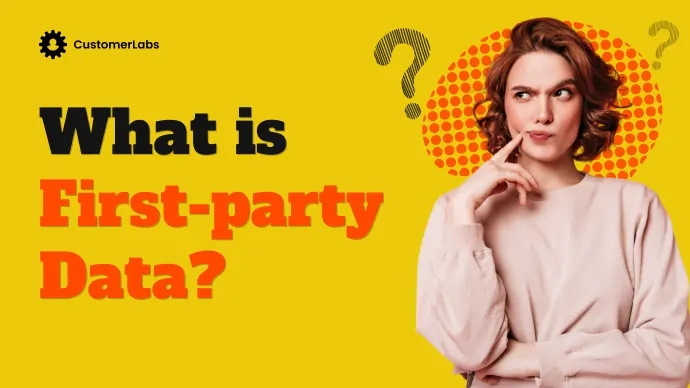Ad optimization has evolved beyond fixing ad creatives and the focus is slowly shifting towards the quality of data that is sent to ad platforms. On one hand, with third-party data slowly fading away due to third-party cookie deprecation and privacy restrictions. And on the other, recently passed privacy laws like HIPPA have made ad platforms rethink the data that they receive for ad optimization.
In today’s stance, every marketer is forced to build their marketing strategy on solid, reliable data to provide personalization and to stay privacy compliant. And it is evident that the data shift is happening gradually and many big brands have already started utilizing first-party data for their marketing needs,which emphasis on the importance of first party data
This makes you ponder how and why first party data is important all of a sudden.
Let’s get started with the blog, where you’ll get to know more about first-party data and the importance of first party data in today’s marketing landscape.
What is First-Party Data?
Putting it in simple terms, it is your own data that you collect from your own users or customers across multiple sources, be it offline or online.
First-party data is not just limited to that; even your business data—the stocks, revenue, profits, etc.—are also first-party data.
So what makes first-party data better than the other types of data? Let’s compare
First-party data Vs Second-party data
Second-party data is collected from or shared by another party or business that has the same target audience, or ICP. This data might be useful to some extent with building up marketing strategies. But it still lacks ownership; once your partners stop sending in data, your marketing cycle stops as well.
You and your partner might share the same data, but for sure, you won’t have the same set of users. Your audience might not resonate with the messaging that you provide through yourads, as you might be missing information. And this makes second-party data unreliable and ineffective.
But when it comes to first-party data, you will collect them, so you have complete ownership of the data, making it very reliable. And as it is collected from your own business/users, you will be able to identify crucial touch points and make data-driven marketing decisions.
Let me share something with you to elaborate on the importance of first party data.
For instance, when I was working along with my team for the World’s 1st 1PD Ops Summit, one of the sponsors, GoHighLevel, did not want us to share the lead information with them (which will make this a second-party data). Instead, they came up with a win-win marketing strategy. They planned to provide “Scan and Win an iPad” raffles to the attendees. What happens here? The attendees, in excitement to win the iPad, will have to scan and fill out theform with the required information (which becomes first-party data).
First-party data Vs Third-party data
Third-party data is collective data gathered by third-party bokers or vendors from different sources, mostly without the direct consent of the users. The practice of relying on third-party data is coming to a halt due to stricter privacy regulations and potential data loss caused by ad blockers and browser restrictions. Therefore, simply trusting third-party data for your marketing strategy is not wise.
Whereas, first-party data is collected only after explicitly getting consent from the users. This makes first-party data an ideal option for being privacy-compliant and to prevent hefty fines. Since first-party data is collected by server-side tracking from the users, the data stays accurate without being interrupted by the browser restrictions.
First-party data Vs Zero-party data
Zero-party data and first-party data are more similar. The only way they differ from each other is that, zero-party data is provided or shared by users themselves through their interactions with a survey form or by choosing their preferences.
Now that you have understood the what is first-party data and the importance of first party data with a comparison, let’s get into the privacy-compliant aspect of first-party data.
First-party data: A pillar of Privacy Compliance
In the recent days, users have become serious about their privacy and are totally aware of the data they share with businesses. The users privacy concerns paved the way to the rise of privacy laws such as GDPR, CCPA, HIPPA and so on.
As an icing on the cake, tech giants like Meta and Google are reinforcing user privacy by limiting third-party data tracking. And Meta has already restricted events for health and wellness brands to be HIPPA compliant, which has made the health and wellness brands go crazy. Additionally, Google Chrome will entirely phase out third-party cookies, making it crucial for businesses to rely on first-party data.
Consented first-party data is the only way businesses can survive these stricter privacy regulations, while keeping the marketing efforts intact. Since it is collected directly from customers with full consent, first-party data meets GDPR requirements without relying on third-party tracking mechanisms.
With first-party data in place, you don’t really have to sell or buy data from any third parties, while providing users the full right to opt out of tracking or deletion of their data, making it easier to comply with CCPA.
And being HIPPA compliant, healthcare providers can securely collect patient-consented first-party data and share the event data to ad platforms (third party) without sharing any PHI or direct PII information with the users.
Privacy compliance is no longer optional—and first-party data is the only way to balance personalization along with privacy.
Up next, let’s learn more about the value that first-party data holds in the context of marketing.
Why First-Party Data is Considered Valuable
First-party data is considered valuable because of the follow ing reasons:
Accurate and reliable data:
First-party data is directly collected from the user interactions with the businesses. The data is collected in real-time from the people who purchase your product or services. Unlike third-party data, first-party data stays updated with the current interactions of the users, which makes it more accurate data without any data loss.
In terms of marketing, data plays a vital role and data accuracy determines the conversion that you get from the ad campaigns. And First-party data is highly reliable to increase the efficiency of the campaigns in terms of targeting and achieving specific business goals.
Deeper understanding of Customer journey and preferences
Knowing your customers is extremely important to take any marketing decisions. Specifically for running successful ad campaigns, you need to target the right audience who will give you conversions.
First-party data provides deeper and more precise insights about the customer profiles (preferences, interests, demographics, psychographics, buying behavior, etc.). You can understand which touch points is crucial in pushing the user towards conversion. By understanding the users precisely, you can predict the next move ofthe users and plan strategies for every specific buyer persona.
Targeted and Personalized Marketing
Customers engage with brands that offer personalization in their ads. First-party data is the goldmine to employ personalization in your ad campaigns. With the precise first-party data of the users, you can understand the demand or preference of the audience. Following which, you can personalize the messaging that you deliver through the ads in the right place to the right person at the right time.
Gain Users trust with Consented data
First-party is not just about understanding your customer behavior but also choosing to respect their privacy. A user’s top concern is to be informed about the collection and usage of their data. The collection of first-party data is made only after showing explicit consent to the users, giving them a choice to opt out.
Being transparent with the users on these aspects will help gaining their trust. With first-party data, users will feel that their data is safe and used for the right reasons.
Now that you understand the importance of first party data, I believe that first-party would have found value in your eyes 😜
Let’s move along and get to know how first-party data can be beneficial for your business growth.
Benefits of First-Party Data for Business Growth
Breaking down one benefit at a time
Higher customer retention and loyalty
Business Growth can be determined by its loyal customers. Acquiring a new customer is five times more expensive than retaining an existing one, and first-party data is key to creating a strong retention strategy.
With first-party data, you can send hyperpersonalized emails, SMS, or ads to your customers based on their behavioral data.
For instance, a subscription-based business like Spotify or Netflix uses first-party data to track user preferences and listening/viewing habits. If a subscriber’s engagement drops, they send personalized content suggestions, exclusive deals, or reminders to keep the user engaged—reducing churn rates and increasing lifetime value.
You can also build some loyalty programs in order to keep the customer engaged. For customers to make repeated purchases, you can send in product- or category-specific offers or even provide them with loyalty points, which they can use during the next purchases. These points make them spend more and advocate for your brand, with fewer ads spent.
Improved advertising efficiency (less ad waste)
The most common challenge while running ad campaigns is high CAC, where the ad algorithms find it difficult to find the right audience for them who will convert. This is exactly why you see an increased CPC or CPA in your campaigns.
It is important to understand that ad platforms are AI machine learning models, which will need proper data to target the audience effectively. With first-party data, you can send in the right data signals to train the ad algorithms to run effectively with lesser efforts, reducing your CAC.
With solid first-party data, you can do more precise targeting. For instance, instead of going behind a broader audience, you can segment the audience based on the user behavior and do personalized targeting. By using this first-party data strategy, you can invest the ad spend on the proper target audience, which will reduce your wasted ad spend.
Better cross-channel marketing strategies
It’s 2025 and if you are still dependent on just one marketing channel, then I really want toknow why.
Customers engage with brands on multiple platforms, such as websites, social media, ads, emails, apps and many more. And all these touch points influence a user to make a conversion (purchase). First-party data consists of crucial touch points of the users from the websites, apps, ads, offline in-store purchases, customer support, surveys, and organic engagement data in social media.
Unlike third-party data, you can integrate these touch points into a unified customer profile, which allows you to track customer interactions across channels. This helps to maintain the same messaging throughout all the marketing channels. Additionally, first-party data helps to understand which marketing channels drive conversions, which aids you in allocating budget effectively.
These are a few benefits of first-party data (but not limited to) that can help your business grow. Also learn on effective clearance sale ads strategy with first-party data.
Up next, let’s get into some interesting use cases that you can add to your marketing strategy if you are missing out on these.
Uses Cases of First-party data for Marketing
Personalized Marketing
First-party data enables businesses to tailor their marketing efforts to individual customer preferences and behaviors, leading to more relevant and engaging experiences.
According to a report, 73% of customers expect personalization from the brands as technology advances, and also feel that the majority of the brands still do not provide it.
a. Dynamic Product Recommendations
By analyzing customers browsing history, buying behavior, and preferences, you can optimize ads provide personalized product recommendations. This approach increases the likelihood of additional purchases and enhances the overall shopping experience.
For instance, if you are an e-commerce brand, you can use first-party data to recommend products, encouraging upselling and cross-selling. If a user had already both shoes from your website, you can show ads with comfy shocks pairs, shoe polishes, covers and other accessories similar to previously viewed or purchased products.
b. Customized Email Campaigns Based on Past Purchases
With first-party data, you can send targeted emails featuring products or services that align with a customer’s interests. This personalization fosters a deeper connection and encourages users to repeat purchases.
Example: As a fashion retailer, you can send personalized emails showcasing new arrivals or promotions related to a customer’s past clothing purchases, increasing the chances of engagement.
c. Tailored Website Experiences
Not just with SMS or email personalization, you also create personalization or tweak the churned-out touch points on the website with first-party data. Based on the user behavior on the website, you can understand and customize webpages to create a more engaging and relevant experience.
Imagine you have a lot of users coming inside the website but conversions is pretty low. It may be due to the user-friendliness of your site. With first-party data, you can pin point the loopholes that do not align with a user or interrupt their experience on the site, enhancing user retention.
Ad Campaign Optimization (Meta, Google Ads, etc.)
Ad platforms are designed as AI models where you need to feed in appropriate data for them to run effectively. With the decline of third-party cookies, platforms like Meta Ads and Google Ads increasingly rely on first-party data for effective audience targeting and remarketing.
Enhanced Precision Targeting
By leveraging first-party data, you can do precise audience targeting. You can create precise targeting strategies, leading to more effective ad targeting and improved return on investment.
Since first-party data has no data loss, unlike third-party data, you can target the users behaviour based on activities like add to cart, blog readers, product page visitors, By precise targeting, you can increase the conversion rates.
Customer Journey Mapping & Predictive Analytics
Analyzing first-party data helps you to understand the customer journey and anticipate future behaviors, allowing for proactive engagement strategies.
a. Comprehensive Customer Journey Mapping
By tracking interactions across various touchpoints, you can visualize the customer journey by analyzing multiple touch points and identify opportunities to enhance the experience and address potential pain points.
For example, a telecommunications company can map out the customer journey from initial inquiry to service activation, identifying stages where customers may require additional support.
b. Predictive Analytics for Proactive Engagement
Utilizing predictive analytics on first-party data allows you to forecast customer needs, understand the demand and enable timely and relevant interventions and innovations.
If you are a subscription service platform, you can predict when a customer is likely to churn based on usage patterns and proactively offer tailored incentives to retain them.
Better Audience Segmentation and Retargeting
First-party data allows you to segment the audience based on specific criteria, leading to more personalized marketing efforts and effective retargeting strategies.
a. Detailed Audience Segmentation
By analyzing demographics, behaviors, and preferences, you can create detailed audience segments, ensuring that marketing messages resonate with each group. You can send audience more precisely; for instance, you can segment the audiences based on AOV (Average Order Value), you can send in high-value products targeting the high AOV segment, thereby increasing the conversion rate and ROAS.
Additionally, you can segment users who have purchased a with offers during the flash sale; you can target such groups with more personalized discounts or offers to make them repeat purchases.
b. Precision Retargeting
First-party data enables you to re-engage users who have interacted with your brand but haven’t converted, keeping the brand top-of-mind and encouraging completion of the desired action. With audience segmentation, you can segment them more granularly as users who viewed the product more than 3 times a week, users who abandoned the cart and did not view again for 2 days and more strategically.
For instance, you can setup retargeting ads to users who abandoned their shopping carts, offering incentives like discounts to encourage purchase completion.
After understanding the importance of first party data, let’s get into the details on the collection of first-party data.
How to Collect First-Party Data?
You can collect first-party data from multiple sources and they are listed down below:
- Website & App Tracking: Implement server-side tracking to track user data on the server-side without any interruption of the web blockers. With tools like Google Analytics that monitor user interactions on your digital platforms (website or app), they will provide insights into behavior, preferences, and engagement patterns.
- CRM & Customer Feedback: Implement CRM platforms to gather, store and manage customer data, including contact information and interaction or purchase history. Deploy surveys and feedback forms to gather insights on customer satisfaction and preferences. Tools like SurveyMonkey facilitate this process.
- Subscription Forms, Surveys, and Lead Magnets: Offer newsletters or exclusive content in exchange for email sign-ups, building a database for direct communication. Provide valuable resources like e-books or whitepapers in exchange for contact information, attracting potential leads. Engage users with quizzes or polls that reveal insights about their preferences, collecting data in the process.
- Loyalty Programs and Memberships: Implement programs that reward customer engagement, which encourage data sharing and foster loyalty. Encourage customers to join membership programs for exclusive benefits, through which you can gather demographic and preference data. Implement referral incentives where customers provide contact information of potential leads, expanding your customer base.
- Event Tracking and Purchase History: Monitoring specific user actions and transaction histories provides insights into customer behavior and preferences. Set up custom events tracking for specific actions like button clicks or video views to understand user engagement with site elements. Analyze transaction data to identify buying patterns, informing inventory and marketing strategies.
Now you know how strategically to collect first-party data, but there are challenges in collecting first-party data that need to be addressed.
Challenges of First-Party Data Collection
Technical Complexity
When it comes to first-party data collection, you will require proper setup and advanced tools and technologies such as Customer Data Platforms (CDPs), Customer Relationship Management (CRM) systems, and analytics tools to effectively collect, store, and analyze data.
The data is collected across websites, apps, offline stores, email interactions, and CRM systems, and implementing these advanced solutions requires expertise in setting up and managing tracking mechanisms like Google Tag Manager, event tracking, and consent management platforms, where you will need the expertise from the developers.
Data Silos The Challenge of Unifying Data
Since data is collected across multiple platforms, one of the biggest challenges is data silos, where different departments collect data separately without a unified system. Without unification, the data will be fragmented, and the customer profiles will remain incomplete, which will not help you take data-driven decisions or build a marketing strategy that will help you grow your business. And implementing multiple tools for collection, storage, unification and activation will definitely cost you heavily.
Even when you want to shift to first-party data, you need to overcome these primary challenges; if not, you cannot see the results properly.
Up next is the one-stop solution when it comes to first-party data
One Tool Solution to Leveraging First-Party Data
Implement 1PD Ops (first-party data operations) platforms where you can collect, unify, segment, and activate your first-party data without any hassle.
With 1PD Ops such as CustomerLabs, you can integrate with multiple sources (website, CRM) and destinations (ad platforms) just in a single platform. CustomerLabs is specifically designed with the motive of reducing the technical complexity with tracking and integrations.
You can segment the audience more precisely and collect custom events to send them across ad platforms for effective targeting. It also enables AI-driven insights for smarter decision-making.
Make your shift to first-party data swiftly for a futuristic marketing experience. Need guidance? Reach out to 1PD Ops experts.







